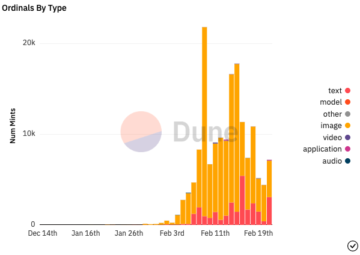
A decline in the network hash rate signals falling miner revenues.
Bitcoin’s recent halving event is delivering a financial blow to mining operators, as their earnings have sharply declined.
Data from Bitinfocharts show that the average transaction fee on April 19, the day of the halving, surged to $127, but has since plummeted over 99% to $1.69.
Bitcoin fees, and therefore miner revenue, has declined as activity around the network’s new non-fungible-like tokens has waned after their initial hype, according to Kaiko Research.
Declining Bitcoin miners’ revenue means operations need to focus on cost-cutting, seek more efficient energy sources and, in some cases, even shut down, potentially reducing network decentralization.
“Everyone is feeling the squeeze post-halving,” said Manthan Dave, Co-Founder of Ripple-backed digital asset custody platform, Palisade. “We will see smaller, less efficient mining setups struggle or collapse. Consolidation will continue, sparking fears about centralization.”
Bitcoin halving is a pre-programmed event that occurs approximately every four years, cutting the reward miners receive for completing a block by half. This process reduces the rate at which new Bitcoins are generated, thereby limiting supply. The most recent halving occurred last month, and the next one is expected in 2028.
Kaiko Research mentioned that miners often consider Bitcoin holdings as liquid assets, selling them to cover operating costs. For instance, Marathon Digital Holdings holds 17,631 BTC worth over $1.1 billion, while Riot Platforms holds 8,872 BTC valued at over $500 million.
“If miners were forced to sell even a fraction of their holdings over the coming month this would have a negative impact on markets,” the research said.
Declining Revenues
Signs of declining miner revenues can be observed through a decrease in the network hash rate, according to CryptoQuant analyst JA Maartun.
Data from blockchain.com shows that on the day of the halving, the Bitcoin hash rate peaked at 650 exahashes per second (EH/s), while it currently stands at 591 EH/s. Although this decline is still modest and brief, it stands out because “the hashrate typically rises [post-halving],” said Maartun.
The hash rate measures the computational power used by miners to solve cryptographic puzzles and validate transactions. It is expressed in exahashes per second (EH/s), indicating the number of calculations performed per second across the network.
Maartun explains that periods of rapid declines in the hashrate often indicate miner capitulation. “In practice, ‘miner capitulation’ means less efficient miners are withdrawing.”
He added, “[Miners] They are turning off their machines, resulting in less computational power available for mining. Additionally; they might [be] relocating to other areas or selling recently mined bitcoin to cover operational costs.”
Operational Changes
Andy Fajar Handika, CEO and co-founder of Bitcoin mining pool Loka Mining, told The Defiant that the decline in Bitcoin mining revenues has prompted miners to make operational changes, including upgrading to newer ASICS machines. “Investing in newer machines is a priority to reduce operational costs and cope with the reduced revenues resulting from the post halving side effects.”
One of the biggest factors in maintaining profitability post-halving is securing cheaper electricity, Handika emphasized. “Many miners have considered or already relocated to regions with cheaper electricity. Ethiopia has now become one of the hottest miners spots with low energy cost.”
Bitcoin nodes, which are computers running the Bitcoin software to validate transactions and maintain the blockchain network, have decreased.
The number of BTC nodes on the day of halving was 18.59K, while it currently stands at 17.3K nodes, representing a 6.92% drop, data from Coin.dance shows.
This reduction means fewer participants are actively validating transactions, leading to potential centralization concerns as it diminishes the number of independent entities ensuring the Bitcoin network’s integrity.
BTC Production Drops
In April, major Bitcoin companies such as Marathon Digital Holdings (MARA), Core Scientific (CORZ), and CleanSpark (CLSK), among others, collectively produced 5,139 BTC, data from The Miner Mag shows.
This represents a 9.41% decline from March, which saw 5,673 BTC produced, and a more significant drop of 34.71% from December’s production of 7,873 BTC — the highest recorded in both 2023 and 2024.
Marathon Digital Holdings led the pack in April with an output of 850 BTC. Core Scientific followed closely, producing 813 BTC, while CleanSpark contributed 721 BTC.
Future Outlook
Dave pointed out that miners exiting due to high costs might shift to other crypto activities.
“They are likely to reuse their hardware and switch to mining on other chains or redeploy capital into other operations such as staking,” he suggested.
Looking ahead, Ryan Song, head of CoinWestern Ventures, a Bitcoin mining consultancy firm, told The Defiant that miners are likely to diversify their ventures into fields such as artificial intelligence (AI), gaming, and machine learning. He explained that miners can repurpose their powerful computers for more profitable activities.
“By using their advanced hardware, miners can train AI models,” he said. “This requires a lot of processing power to recognize patterns, make decisions, and predict outcomes efficiently.”
In the gaming industry, miners’ expertise can be applied to rendering high-quality graphics, a process that needs computational resources.
Song also mentioned that miners could support complex machine learning algorithms. “These algorithms need a lot of computing power for data analysis and learning processes,” he noted. “By shifting to these activities, miners can secure new revenue streams while ensuring the long-term sustainability of their operations.”
As for Bitcoin, while investors cheered because the supply was reduced, it turns out that miners force-selling BTC to cover costs means the halving outcome isn’t so straightforward.
- SEO Powered Content & PR Distribution. Get Amplified Today.
- PlatoData.Network Vertical Generative Ai. Empower Yourself. Access Here.
- PlatoAiStream. Web3 Intelligence. Knowledge Amplified. Access Here.
- PlatoESG. Carbon, CleanTech, Energy, Environment, Solar, Waste Management. Access Here.
- PlatoHealth. Biotech and Clinical Trials Intelligence. Access Here.
- Source: https://thedefiant.io/news/blockchains/bitcoin-halving-strains-miners-as-revenues-drop
- :has
- :is
- 1
- 17
- 19
- 2023
- 2024
- 2028
- 203
- 34
- 5
- 6
- 69
- 7
- 721
- 8
- 9
- a
- About
- According
- across
- actively
- activities
- activity
- added
- Additionally
- advanced
- After
- ahead
- AI
- AI models
- algorithms
- already
- also
- Although
- among
- an
- analysis
- analyst
- and
- applied
- approximately
- April
- ARE
- areas
- around
- artificial
- artificial intelligence
- Artificial intelligence (AI)
- AS
- Asics
- asset
- Assets
- At
- available
- average
- BE
- because
- become
- Biggest
- Billion
- Bitcoin
- Bitcoin halving
- bitcoin hash rate
- Bitcoin mining
- Bitcoin Network
- Bitcoins
- Block
- blockchain
- blockchain network
- blow
- both
- BTC
- but
- by
- calculations
- CAN
- capital
- capitulation
- cases
- Centralization
- ceo
- chains
- Changes
- cheaper
- CleanSpark
- closely
- Co-founder
- Coin
- Collapse
- collectively
- coming
- Companies
- completing
- complex
- computational
- computational power
- computers
- computing
- computing power
- Concerns
- Consider
- considered
- consolidation
- consultancy
- continue
- contributed
- Core
- core scientific
- CORZ
- Cost
- Costs
- could
- cover
- crypto
- cryptographic
- cryptoquant
- Currently
- Custody
- cutting
- dance
- data
- data analysis
- Dave
- day
- December
- Decentralization
- decisions
- Decline
- declined
- Declines
- Declining
- decrease
- decreased
- delivering
- digital
- Digital Asset
- Digital Asset Custody
- diversify
- down
- Drop
- due
- Earnings
- effects
- efficient
- efficiently
- electricity
- emphasized
- energy
- ensuring
- entities
- Ether (ETH)
- Ethiopia
- Even
- Event
- Every
- everyone
- Exiting
- expected
- expertise
- explained
- expressed
- factors
- Falling
- fears
- fee
- feeling
- Fees
- fewer
- Fields
- financial
- Firm
- Focus
- followed
- For
- forced
- four
- fraction
- from
- gaming
- Gaming industry
- generated
- graphics
- Half
- Halving
- Hardware
- hash
- hash rate
- Hashrate
- Have
- he
- head
- High
- high-quality
- highest
- Holdings
- holds
- hottest
- HTTPS
- Hype
- Impact
- in
- Including
- independent
- indicate
- indicating
- industry
- initial
- instance
- integrity
- Intelligence
- into
- investing
- Investors
- IT
- Kaiko
- Last
- leading
- learning
- Led
- less
- likely
- limiting
- Liquid
- LOKA
- long-term
- Lot
- Low
- machine
- machine learning
- Machines
- Mag
- maintain
- maintaining
- major
- make
- many
- Mara
- Marathon
- MARATHON DIGITAL
- Marathon Digital Holdings
- March
- Markets
- means
- measures
- mentioned
- might
- million
- mined
- miner
- Miner capitulation
- Miners
- Mining
- mining pool
- models
- modest
- Month
- more
- more efficient
- most
- Need
- needs
- negative
- network
- New
- newer
- next
- nodes
- noted
- now
- number
- observed
- occurred
- of
- off
- often
- on
- ONE
- operating
- operational
- Operations
- operators
- or
- Other
- Others
- out
- Outcome
- outcomes
- output
- over
- Pack
- participants
- patterns
- peaked
- per
- performed
- periods
- platform
- Platforms
- plato
- Plato Data Intelligence
- PlatoData
- pool
- Post
- potential
- potentially
- power
- powerful
- practice
- predict
- priority
- process
- processes
- processing
- Processing Power
- Produced
- producing
- Production
- profitability
- profitable
- Puzzles
- rapid
- Rate
- receive
- recent
- recently
- recognize
- recorded
- reduce
- Reduced
- reduces
- reducing
- reduction
- regions
- Relocated
- rendering
- representing
- represents
- requires
- research
- Resources
- resulting
- reuse
- revenue
- revenues
- Reward
- Riot
- Rises
- running
- Ryan
- s
- Said
- saw
- scientific
- Second
- secure
- securing
- see
- Seek
- sell
- Selling
- shift
- SHIFTING
- Shows
- shut
- Shut down
- side
- signals
- significant
- since
- smaller
- So
- Software
- SOLVE
- some
- song
- Sources
- spots
- Squeeze
- Staking
- stands
- Still
- straightforward
- Strains
- streams
- Struggle
- such
- supply
- support
- Surged
- Sustainability
- Switch
- that
- The
- The Defiant
- their
- Them
- thereby
- therefore
- These
- they
- this
- Through
- to
- Tokens
- told
- Train
- transaction
- Transactions
- Turning
- turns
- typically
- used
- using
- VALIDATE
- validating
- valued
- Ventures
- waned
- was
- we
- were
- which
- while
- will
- with
- withdrawing
- worth
- would
- years
- zephyrnet










